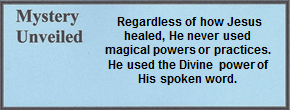10.01.28 Mk. 8:22-26 Bethsaida
BLIND MAN HEALED WITH SPIT AND THE LAYING ON OF HANDS
22 Then they came to Bethsaida. They brought a blind man to Him and begged Him to touch him. 23 He took the blind man by the hand and brought him out of the village. Spitting on his eyes and laying His hands on him, He asked him, “Do you see anything?”
24 He looked up and said, “I see people – they look to me like trees walking.”
25 Again Jesus placed His hands on the man’s eyes, and he saw distinctly. He was cured and could see everything clearly. 26 Then He sent him home, saying, “Don’t even go into the village.”
A question often asked is why did Jesus use spit or spit and mud to heal the blind man.[1] See Rabbi John Fischer’s response in 10.01.28.V, as well as 11.02.21.Q1.
This is the only recorded miracle that was performed in two stages. Just as the blind man had attained partial sight, so likewise the disciples understood only in part. The blind man was reflective of both the disciples and national Israel. Later, after Pentecost, the disciples fully understood and after the resurrection of the two witnesses (Rev. 11) Israel will fully understand the work and message of Jesus.
The unique feature of this miracle is that it was a two-part miracle. How could Jesus perform a healing that, for whatever reason, did not result in a complete healing in His first attempt? “Spitting on his eyes and laying His hands on him.” Jesus healed this man in a double treatment. After the partial healing the man said, “I see people,” but they were blurred. The healing was obviously not complete. Yet the fact that he recognized people and trees indicates that he was not born blind. The only other incident that is similar to this is recorded in John 9 where the blind man’s eyes were coated with clay and he was told to wash in the Pool of Siloam (see 11.02.21).
There is, however, extra-biblical literary evidence that suggests the application of saliva for the healing of the eyes was an accepted healing method. A certain Rabbi Meir stated that a woman was famous for her ability to heal sick eyes with her saliva.[2] Since he accepted this as a legitimate medical practice, it was not looked upon as any kind of charm or magic. Furthermore, the Babylonian Talmud confirmed it.[3] However, healing with saliva on the Sabbath was forbidden unless it was thought to save a life.[4]
The point of interest in this Jewish account is that since it was perceived as a legitimate medical procedure and not some form of witchcraft, the actions of Jesus would have been likewise understood as a legitimate and not witchcraft.[5]
10.01.28.Q1 What was the purpose of the two-step healing process in Mark 8:22-26?
The two-step method of healing a blind person has been problematic for students of the Bible. The unspoken issue is, of course, if Jesus is the all-powerful Healer, why wasn’t the man healed the first time? Since it is the only two-step miracle in the gospels, there may be a prophetic element hidden in this event. While there is no clear answer, it has been suggested that this is parallel to the following:
- The two-step healing is parallel to the understanding of the disciples. They had been with Jesus all this time by still had a limited understanding of His message and ministry – but their full understanding or “second healing of understanding” was to come after His resurrection.
- Another parallel pertains to national Israel. The religious leaders had a limited understanding at this time, but after their rejection of Jesus, they would be blinded for a while. Israel’s vision for the plan of God will be “healed” after the fullness of the Gentiles is completed. At that time, all Israel will have full understanding and be saved as the Apostle Paul stated in Romans 11:25-27.
Therefore, the blind man was a “type and shadow” of both the disciples and national Israel.
Video Insert >
10.01.28.V Clarification of Yeshua’s Unusual Healing Methods. Messianic Rabbi John Fischer, discusses two healing methods of blind men that have challenged Bible students. Why did Jesus (Yeshua) heal with spit and the laying on of hands in John 9:1-12, and what was the purpose of the 2-step healing process in Mark 8:22-26?
“Don’t even go into the village.” Again, Jesus desired that the news of His miracle not be spread throughout the community.[6] Jesus was aware of the fact that the villagers were about to reject Him, yet He was willing to meet the needs of anyone who personally came to him. After the man was healed, he was instructed not to return to the village, presumably because of their hostility and unbelief.

[1]. There were four kinds of people that were considered as good as dead, and it was believed that in all four situations their situation was a divine judgment. They were the blind, the leper, the poor, and the childless.
[2]. Jerusalem Talmud, Sotah 16, 4.
[3]. Babylonian Talmud, Sanhedrin 101a.
[4]. Babylonian Talmud, Sanhedrin 101b.
[5]. For more information on this interesting subject, see 11.02.21.Q1 “Why did Jesus use spit and mud to heal the blind man in John 9:1-12?”
[6]. See comments on Mt. 8:1-4 and the Psalms of Solomon.